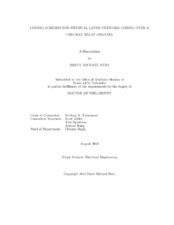| dc.contributor.advisor | Narayanan, Krishna R. | |
| dc.creator | Hern, Brett Michael | |
| dc.date.accessioned | 2013-12-16T20:04:51Z | |
| dc.date.available | 2015-08-01T05:48:29Z | |
| dc.date.created | 2013-08 | |
| dc.date.issued | 2013-08-09 | |
| dc.date.submitted | August 2013 | |
| dc.identifier.uri | https://hdl.handle.net/1969.1/151149 | |
| dc.description.abstract | We consider a two-way relay channel in which two transmitters want to exchange information through a central relay. The relay observes a superposition of the trans- mitted signals from which a function of the transmitted messages is computed for broadcast. We consider the design of codebooks which permit the recovery of a function at the relay and derive information-theoretic bounds on the rates for reliable decoding at the relay.
In the spirit of compute-and-forward, we present a multilevel coding scheme that permits reliable computation (or, decoding) of a class of functions at the relay. The function to be decoded is chosen at the relay depending on the channel realization. We define such a class of reliably computable functions for the proposed coding scheme and derive rates that are universally achievable over a set of channel gains when this class of functions is used at the relay. We develop our framework with general modulation formats in mind, but numerical results are presented for the case where each node transmits using 4-ary and 8-ary modulation schemes. Numerical results demonstrate that the flexibility afforded by our proposed scheme permits substantially higher rates than those achievable by always using a fixed function or considering only linear functions over higher order fields.
Our numerical results indicate that it is favorable to allow the relay to attempt both compute-and-forward and decode-and-forward decoding. Indeed, either method considered separately is suboptimal for computation over general channels. However, we obtain a converse result when the transmitters are restricted to using identical binary linear codebooks generated uniformly at random. We show that it is impossible for this code ensemble to achieve any rate higher than the maximum of the rates achieved using compute-and-forward and decode-and-forward decoding.
Finally, we turn our attention to the design of low density parity check (LDPC) ensembles which can practically achieve these information rates with joint-compute- and-forward message passing decoding. To this end, we construct a class of two-way erasure multiple access channels for which we can exactly characterize the performance of joint-compute-and-forward message passing decoding. We derive the processing rules and a density evolution like analysis for several classes of LDPC ensembles. Utilizing the universally optimal performance of spatially coupled LDPC ensembles with message passing decoding, we show that a single encoder and de- coder with puncturing can achieve the optimal rate region for a range of channel parameters. | en |
| dc.format.mimetype | application/pdf | |
| dc.language.iso | en | |
| dc.subject | Two-Way Relay Channel | en |
| dc.subject | Physical Layer Network Coding | en |
| dc.subject | Information Theory | en |
| dc.subject | Channel Coding | en |
| dc.subject | Multilevel Coding | en |
| dc.title | Coding Schemes for Physical Layer Network Coding Over a Two-Way Relay Channel | en |
| dc.type | Thesis | en |
| thesis.degree.department | Electrical and Computer Engineering | en |
| thesis.degree.discipline | Electrical Engineering | en |
| thesis.degree.grantor | Texas A & M University | en |
| thesis.degree.name | Doctor of Philosophy | en |
| thesis.degree.level | Doctoral | en |
| dc.contributor.committeeMember | Miller, Scott | |
| dc.contributor.committeeMember | Sprintson, Alex | |
| dc.contributor.committeeMember | Jiang, Anxiao | |
| dc.type.material | text | en |
| dc.date.updated | 2013-12-16T20:04:52Z | |
| local.embargo.terms | 2015-08-01 | |


